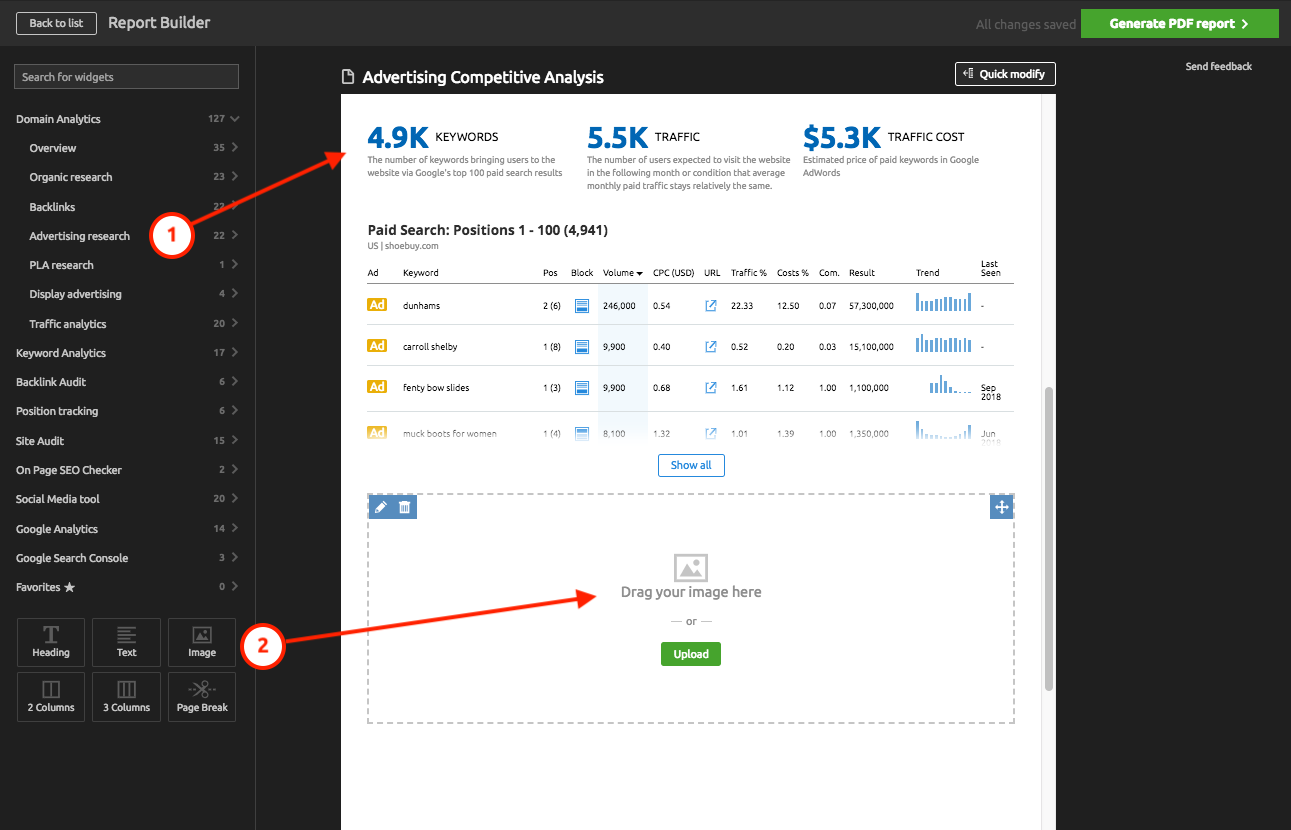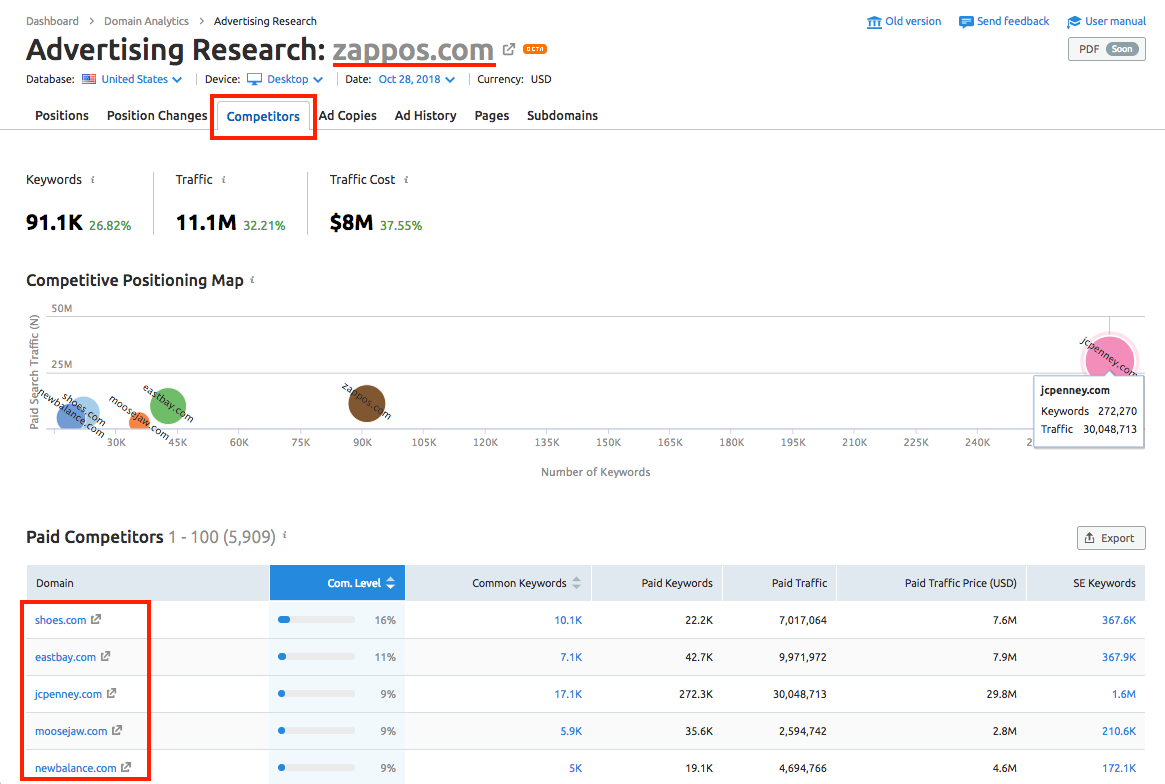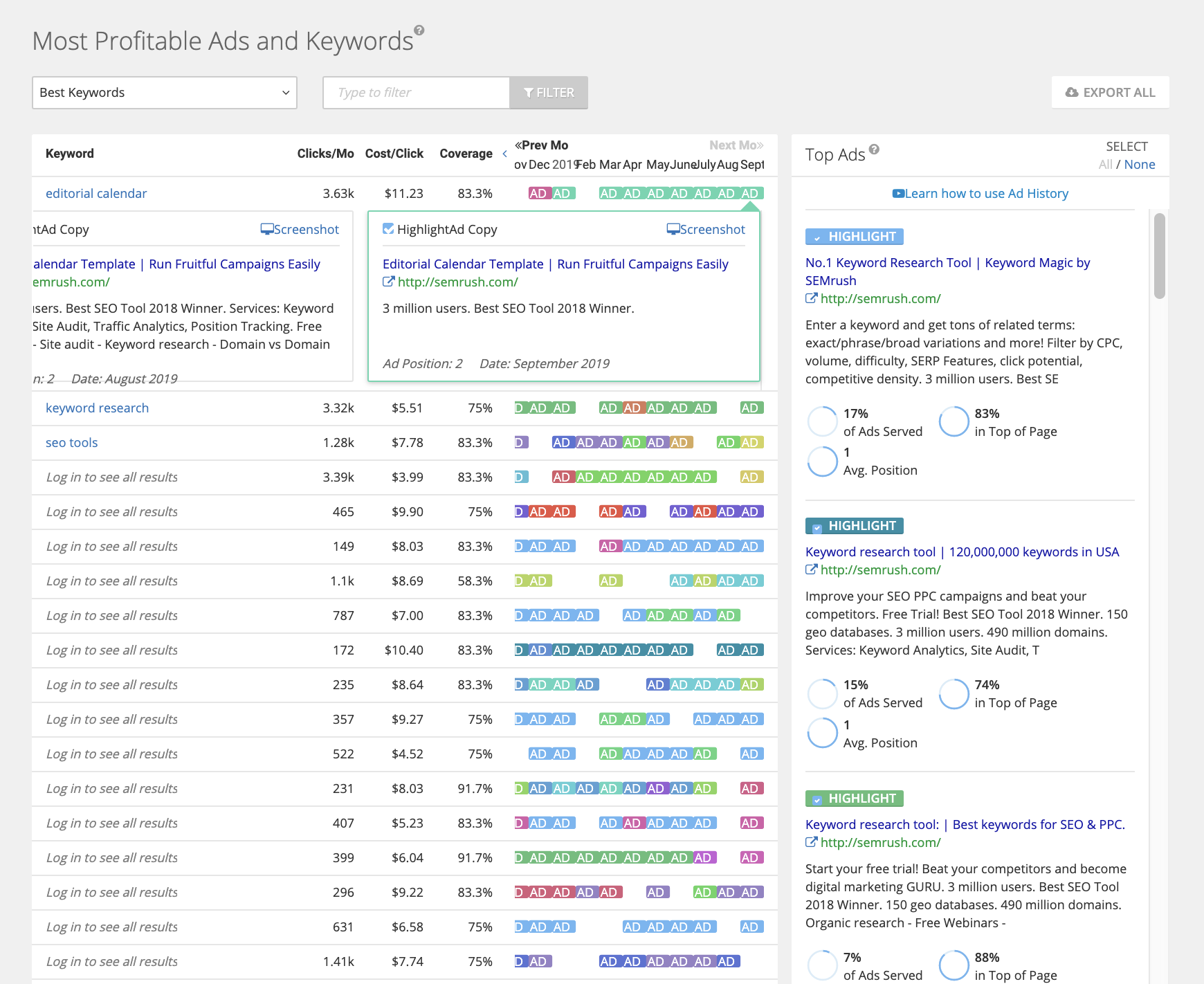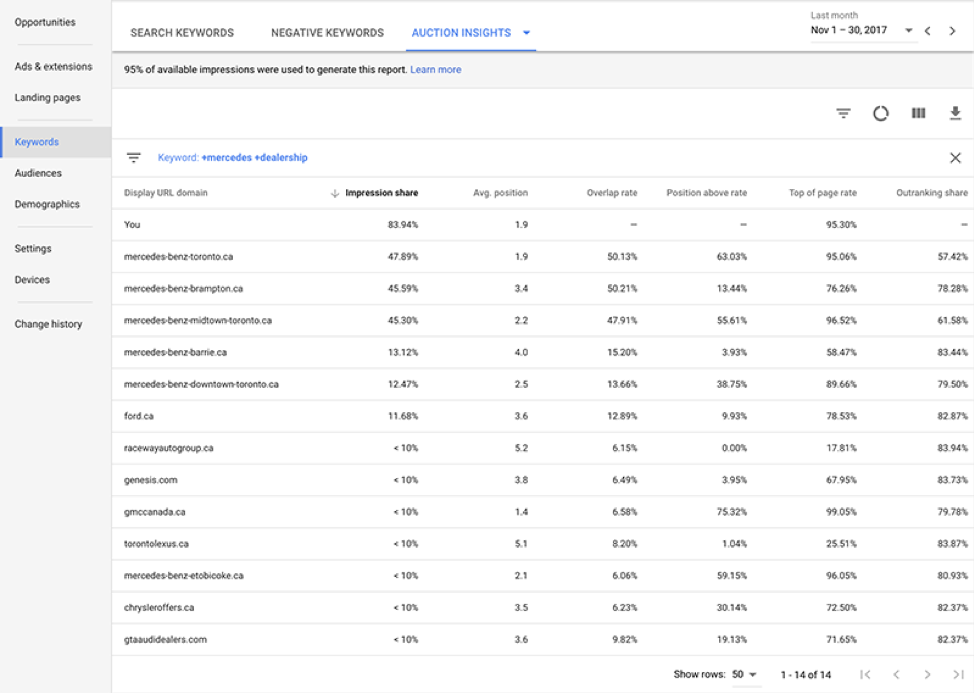If you were to launch a brand new PPC campaign tomorrow, how would you go about it?
If you didn’t have access to a tool that could create and launch a new campaign in one day, would you instead…
- Do some quick PPC keyword research to develop a top-level keyword list quickly?
- Figure out which audiences are most likely to convert?
- Write a bunch of great PPC ads?
- Create at least one or two landing pages that closely match your ads?
That could get you ready to launch in one day. It’d be a long day, and you’d have a lot of refinements to do later on, but it could be done.
Or… if you wanted to “cheat,” you could fire up a few PPC competitive analysis tools, run a few quick analyses, and duplicate your closest competitors’ PPC campaigns. Then you’d just need to add some specifics about your product or services in your ads.
And you’d be done. Ready to launch a nice shiny-new PPC campaign. In a day.
Even if you don’t need to do a hyperfast PPC campaign launch like that, doing regular PPC competitive analyses can have a huge impact on the performance of your campaigns. PPC advertising is just too ferociously competitive now not to be doing competitive analysis. It’s a tactic most of your competitors are using already… on you.
In fact, if you haven’t been doing regular competitive analysis of your competitors’ PPC campaigns, we’d wager you’re missing out on at least 10-20% of the return on ad spend you could otherwise be earning.
But maybe you know all this already. You know competitive analysis works, and you’re doing as much of it as you can. Or at least it’s on your to-do list. You’d do more of it, of course… if only you had the time.
That’s a reasonable excuse, but if you can reset your mindset just a little, you might find you actually do have the time.
How to Avoid Analysis Paralysis in PPC Competitive Analysis
Competitive analysis, like most other types of analysis, can tip into “analysis paralysis” if we’re not careful. We all want to do a good job, after all.
But while it’s great to have all sorts of tools available, it’s easy to get lost in the weeds. Add in how crazy-complex many PPC accounts are now, and even a “simple analysis” can become a headache-inducing exercise.
So while you should do competitive analysis, you don’t need to do it to the point of exhaustion. And really… is there any point to doing more analysis than you can actually act on?
So what’s the limit of analysis you can act on? It depends on your resources. Are you part of a PPC team of ten, or one? Are you managing just your own PPC account, or the PPC accounts of dozens of clients?
If it’s just you and you’ve got lots of clients, you’re probably already buried in stuff to do. So consider aiming for one to two hours of competitive analysis per week.
That’s not a lot, but if you’ve got access to a few competitive analysis tools, it may be enough. But here’s the real trick: 80/20 the whole exercise.
Not familiar with 80/20? It refers to the 80/20 rule, which is the idea that in most systems, 80% of the results come from 20% of the effort. This ratio can be 90/10, and it can even be 97/3. Whatever the ratio, this rule applies to most PPC accounts and campaigns. Usually there are just a handful of ad groups, audiences, keywords or campaigns that drive the bulk of results. And if they aren’t driving the bulk of your results, they’re driving the bulk of your spending.
If you don’t have the bandwidth to do competitive analysis for your entire PPC account, focus on the highest-value parts of your campaigns and monitor their competition. Focus it on the part of your PPC advertising that’s driving the bulk of your results.
Alternatively, you could break out your competitive analysis into four “buckets” (four aspects or parts of your accounts), then spend time on each aspect of your account or accounts every month.
If you’re in a reasonably stable bidding environment, and especially if you have good reporting set in place to help you auto-monitor your campaigns, checking up on competitors every month or so is sometimes enough. It’s not optimal, but if your resources and time are limited, it’s enough to make a meaningful difference in your campaigns’ performance. And it’s way better than doing no competitive analysis at all.
Of course, if you’re tight on time, having a good PPC competitive research tool can help. Machine learning and AI have made competitive analysis easier and more effective than ever before.
5 PPC Competitive Analysis Tools for Time-Starved PPC Marketers
SEMRush offers a slew of tools for PPC marketers, and their competitive analysis tool is one of the most helpful. And you can create an automatically generated competitive analysis report, which could save you yet more time. If you’re an ad agency or a marketing consultant, it’s also possible to get those reports as PDFs which you could then share with your clients.

SEMRush’s competitive analysis tool will let you see and analyze your competitors in Google Shopping, Google’s Display Ad Network, in Google’s Search Network (including your competitors’ keywords).
It will also show you who your competitors are in each network. This can be surprising – the companies we might think of as being competitors sometimes aren’t the ones actually bidding against us.

If you wanted to duplicate a competitor’s PPC account overnight, SpyFu would be the tool to do it with. Their homepage expressly touts that capability: “Download Your Competitors’ Most Profitable Keywords and Ads For Paid and Organic Search.“
Even SpyFu’s free version can give you a taste of information about a competitor’s ads, but you will need the paid version ($39 a month) to really do your work. Here’s a screenshot of what their free version told me about one of SpyFu’s own competitors:

See how they ranked the keywords and ads by most profitable? That’s a critical thing to remember about PPC competitive analysis. You want to be “borrowing” or testing your competitors’ most profitable ads, keywords, and audiences. Just because a competitor is running a particular ad or bidding on a particular keywords doesn’t necessarily mean it’s profitable for them. Don’t duplicate your competitors’ mistakes.
PPC competition can come from anywhere – including from affiliates, resellers, and even partners. Brandverity specializes in monitoring and managing that kind of PPC competition. Its other superpower is monitoring your branded keywords. Those are especially valuable terms, and your competitors know it.
Starting at $59 per month, Ispionage will give you “access to seven years worth of PPC and SEO keyword data that covers the top three search engines—Google, Bing, and Yahoo—and includes 92,000,000 keywords, 108,000,000 ad copy variations, and 45,000,000 domains.”
Given that the average cost per click for B2B firms is $3.33, that means you could get access to some pretty valuable competitive data for the cost of about 18 clicks.
What’s especially interesting about Ispionage is the historical data. It’s one thing to know what your competitors are doing now, but if you can see what they had been doing – what they’ve continued to do month after month, or what they tried for a bit and then stopped – that strongly suggests what’s working for them and what’s not.
That’s exactly the verification you need. Again, we don’t want to recreate our competitors’ mistakes. The goal of competitive research is to use our competitors’ campaigns and ad budgets like our own free test lab. Let them spend the money testing different ad formats, extensions, ad copy and ad types. We can monitor what they do and then duplicate their best moves.
-
Google Ads Auction Insights.
You can find Auction Insights in Google’s Keyword Planner. The data it will give you looks like this:

Here’s what each of those metrics means:
- Impression Share. How many times your ads have appeared in keyword searches compared to your competitors’ ads.
- Absolute top of the page rate. This new metric has replaced our old friend average position, which was sunsetted on September 30th. Google defines absolute top of the page as “how often your ad (or the ad of another participant, depending on which row you’re viewing) was shown at the absolute top of the page as the very first ad above the organic search results.”
- Position above rate. This “is how often the other participant’s ad was shown in a higher position than yours was, when both of your ads were shown at the same time.”
- Overlap Rate: “How often another participant’s ad received an impression when your ad also received an impression.”
- Top of Page Rate: How often your ad (or your competitors’ ads) appear at the top of the search results.
- Outranking Share: Google describes this as “a percentage defined as the number of times your ad ranked higher in the auction than another participant’s ad, plus the number of times your ad showed when theirs did not, divided by the total number of ad auctions you participated in.
Chandal Nolasco Da Silva walks through the capabilities of Google Ad’s Auction Insights in detail in her post, PPC Forecasts and Projections: How to Master Paid Marketing Predictions for Future Success.
Conclusion
As AI and machine learning PPC tools free up more time from daily account management tasks like bid edits, PPC marketers can have more time for other high-return activities they may not have been able to get to before. Competitive analysis is one of those activities.
The automation available for competitive analysis also makes it possible to maximize marketers’ limited time even further. Hopefully, we’ll soon see enough efficiencies with PPC management for marketers to be able to consistently devote 10-15% of their time exclusively to monitoring and analyzing what their competitors are doing.
IMAGES:
- Unsplash, Amanda Dalbjörn
2-3. SEMRush.
- Screenshot taken by the author, October, 2019.
- Acquisio.



